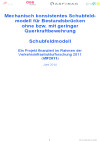Shear area model - Mechanically consistent shear area-model for existing bridges without or with small lateral force reinforcement
Short Description
Starting point / motivation
Most of the existing operational railway and road bridges have not been designed and built according to the current state of the art. The majority of these bridges in the railway and road network are reinforced or prestressed concrete structures.
Due to different design concepts over the years, as well as amended load assumptions, the bridges often show a low shear resistance in regard to the current state of the art. However, most of the bridges are apparently in good condition.
According to [Hegger et al, 22] the calculated deficiency in shear capacity is not a result of the higher characteristic load assumptions of Eurocode 2 compared to older standards, but is caused by changes in the calculation of the shear resistance.
Stricter requirements in constructive design have become a significant influence in regard to the calculated deficiency of the shear resistance of older bridges. Often the existing shear reinforcement of older bridges consists of constructive design considerations rather than on the proof of calculation.
This implicates (particularly in regard to prestressed structures) that the existing shear reinforcement is lower than the minimum shear reinforcement according to EC2.
Contents and goals
The aim of the research project was the development of a mechanically consistent model for determination of the shear resistance of bridges without or with low shear reinforcement based on the stress field model.
Methods
In addition to a literature search and review and a comparison of standards, the influence of the shear span ratio and prestressing on the stress field and the cracking were analysed by an evaluation of databases and finite element analyses. For the modification of the model, experiments already carried out on structural components were recalculated.
Based on the recalculation of selected railway and road bridges the application of the new model was demonstrated. The primary objective was to avoid strengthening or replacing of already existing bridges in good condition due to calculated low shear resistance according to the currently applicable standards.
Results and Conclusions
In the course of this research project the approach that concrete contributes to the removal of transverse forces, was adopted. For this purpose a calculation model was created, which allows the determination of an additive contribution of the concrete to shear force on basis of the bearing capacity of the noncracked concrete pressure zone.
Comparisons with experimental results justified the chosen approach on single-field systems. The applicability was demonstrated by a first implementation of the new model for existing bridges. To what extent this tranverse force behavior also applies in the support area of circulating systems has to be analysed by means of further theoretical considerations and experimental investigations.
Publications
Shear area model - Mechanically consistent shear area-model for existing bridges without or with small lateral force reinforcement

Within the scope of this research project a mechanically consistent model for the shear resistance of bridges without or low shear reinforcement was developed.
Dipl.-Ing. Patrick Huber, Univ.-Prof. Dr.Ing. Johann Kollegger, Univ.-Prof. Dr.Ing. Viet Tue Nguyen, Dr.-Ing. Duc Tung Nguyen
Publisher: BMVIT
German, 251 Seiten
Publication Downloads
Project Partners
Project manager
O.Univ.-Prof. Dipl.-Ing. Dr.-Ing. Johann Kollegger - Technical University Vienna– Institute for support structures
Project partners
Univ. Prof. Dr. Viet Tue Nguyen - Technical University Graz – Institute for concrete construction
Contact Address
Institute for support structures
O.Univ.-Prof. Dipl.-Ing. Dr.-Ing. Johann Kollegger
Tel.: +43 (1) 58801-21202
E-mail: johann.kollegger@tuwien.ac.at
